Yuzhang Shang
AdaTooler-V: Adaptive Tool-Use for Images and Videos
Dec 19, 2025Abstract:Recent advances have shown that multimodal large language models (MLLMs) benefit from multimodal interleaved chain-of-thought (CoT) with vision tool interactions. However, existing open-source models often exhibit blind tool-use reasoning patterns, invoking vision tools even when they are unnecessary, which significantly increases inference overhead and degrades model performance. To this end, we propose AdaTooler-V, an MLLM that performs adaptive tool-use by determining whether a visual problem truly requires tools. First, we introduce AT-GRPO, a reinforcement learning algorithm that adaptively adjusts reward scales based on the Tool Benefit Score of each sample, encouraging the model to invoke tools only when they provide genuine improvements. Moreover, we construct two datasets to support training: AdaTooler-V-CoT-100k for SFT cold start and AdaTooler-V-300k for RL with verifiable rewards across single-image, multi-image, and video data. Experiments across twelve benchmarks demonstrate the strong reasoning capability of AdaTooler-V, outperforming existing methods in diverse visual reasoning tasks. Notably, AdaTooler-V-7B achieves an accuracy of 89.8\% on the high-resolution benchmark V*, surpassing the commercial proprietary model GPT-4o and Gemini 1.5 Pro. All code, models, and data are released.
Distill Video Datasets into Images
Dec 16, 2025Abstract:Dataset distillation aims to synthesize compact yet informative datasets that allow models trained on them to achieve performance comparable to training on the full dataset. While this approach has shown promising results for image data, extending dataset distillation methods to video data has proven challenging and often leads to suboptimal performance. In this work, we first identify the core challenge in video set distillation as the substantial increase in learnable parameters introduced by the temporal dimension of video, which complicates optimization and hinders convergence. To address this issue, we observe that a single frame is often sufficient to capture the discriminative semantics of a video. Leveraging this insight, we propose Single-Frame Video set Distillation (SFVD), a framework that distills videos into highly informative frames for each class. Using differentiable interpolation, these frames are transformed into video sequences and matched with the original dataset, while updates are restricted to the frames themselves for improved optimization efficiency. To further incorporate temporal information, the distilled frames are combined with sampled real videos from real videos during the matching process through a channel reshaping layer. Extensive experiments on multiple benchmarks demonstrate that SFVD substantially outperforms prior methods, achieving improvements of up to 5.3% on MiniUCF, thereby offering a more effective solution.
Can World Simulators Reason? Gen-ViRe: A Generative Visual Reasoning Benchmark
Nov 17, 2025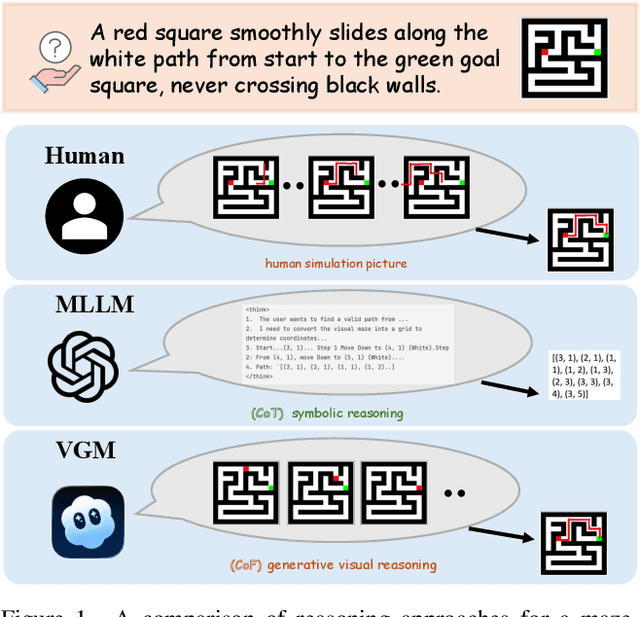
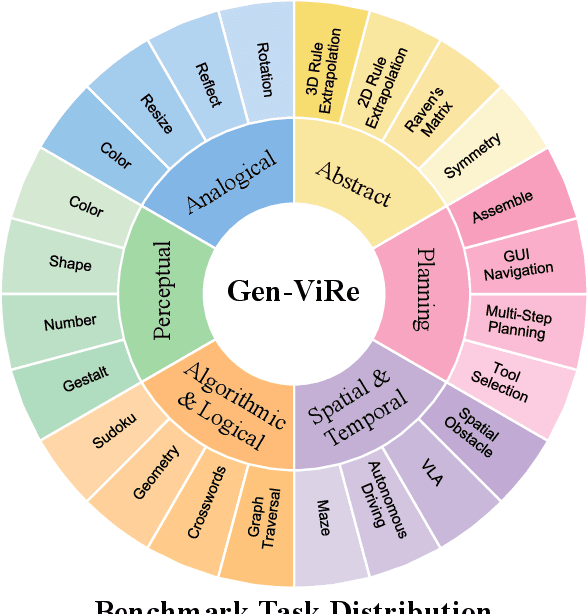
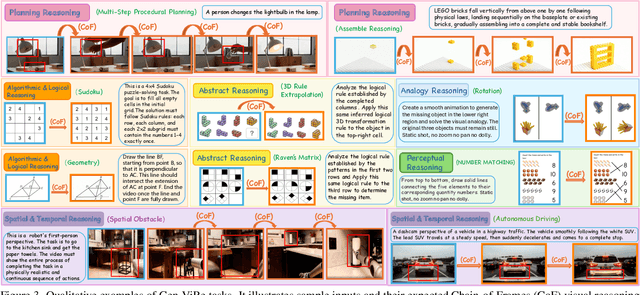
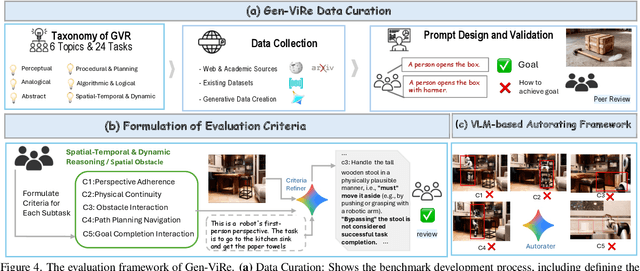
Abstract:While Chain-of-Thought (CoT) prompting enables sophisticated symbolic reasoning in LLMs, it remains confined to discrete text and cannot simulate the continuous, physics-governed dynamics of the real world. Recent video generation models have emerged as potential world simulators through Chain-of-Frames (CoF) reasoning -- materializing thought as frame-by-frame visual sequences, with each frame representing a physically-grounded reasoning step. Despite compelling demonstrations, a challenge persists: existing benchmarks, focusing on fidelity or alignment, do not assess CoF reasoning and thus cannot measure core cognitive abilities in multi-step planning, algorithmic logic, or abstract pattern extrapolation. This evaluation void prevents systematic understanding of model capabilities and principled guidance for improvement. We introduce Gen-ViRe (Generative Visual Reasoning Benchmark), a framework grounded in cognitive science and real-world AI applications, which decomposes CoF reasoning into six cognitive dimensions -- from perceptual logic to abstract planning -- and 24 subtasks. Through multi-source data curation, minimal prompting protocols, and hybrid VLM-assisted evaluation with detailed criteria, Gen-ViRe delivers the first quantitative assessment of video models as reasoners. Our experiments on SOTA systems reveal substantial discrepancies between impressive visual quality and actual reasoning depth, establishing baselines and diagnostic tools to advance genuine world simulators.
Efficient Multimodal Dataset Distillation via Generative Models
Sep 18, 2025Abstract:Dataset distillation aims to synthesize a small dataset from a large dataset, enabling the model trained on it to perform well on the original dataset. With the blooming of large language models and multimodal large language models, the importance of multimodal datasets, particularly image-text datasets, has grown significantly. However, existing multimodal dataset distillation methods are constrained by the Matching Training Trajectories algorithm, which significantly increases the computing resource requirement, and takes days to process the distillation. In this work, we introduce EDGE, a generative distillation method for efficient multimodal dataset distillation. Specifically, we identify two key challenges of distilling multimodal datasets with generative models: 1) The lack of correlation between generated images and captions. 2) The lack of diversity among generated samples. To address the aforementioned issues, we propose a novel generative model training workflow with a bi-directional contrastive loss and a diversity loss. Furthermore, we propose a caption synthesis strategy to further improve text-to-image retrieval performance by introducing more text information. Our method is evaluated on Flickr30K, COCO, and CC3M datasets, demonstrating superior performance and efficiency compared to existing approaches. Notably, our method achieves results 18x faster than the state-of-the-art method.
ButterflyQuant: Ultra-low-bit LLM Quantization through Learnable Orthogonal Butterfly Transforms
Sep 11, 2025Abstract:Large language models require massive memory footprints, severely limiting deployment on consumer hardware. Quantization reduces memory through lower numerical precision, but extreme 2-bit quantization suffers from catastrophic performance loss due to outliers in activations. Rotation-based methods such as QuIP and QuaRot apply orthogonal transforms to eliminate outliers before quantization, using computational invariance: $\mathbf{y} = \mathbf{Wx} = (\mathbf{WQ}^T)(\mathbf{Qx})$ for orthogonal $\mathbf{Q}$. However, these methods use fixed transforms--Hadamard matrices achieving optimal worst-case coherence $\mu = 1/\sqrt{n}$--that cannot adapt to specific weight distributions. We identify that different transformer layers exhibit distinct outlier patterns, motivating layer-adaptive rotations rather than one-size-fits-all approaches. We propose ButterflyQuant, which replaces Hadamard rotations with learnable butterfly transforms parameterized by continuous Givens rotation angles. Unlike Hadamard's discrete $\{+1, -1\}$ entries that are non-differentiable and prohibit gradient-based learning, butterfly transforms' continuous parameterization enables smooth optimization while guaranteeing orthogonality by construction. This orthogonal constraint ensures theoretical guarantees in outlier suppression while achieving $O(n \log n)$ computational complexity with only $\frac{n \log n}{2}$ learnable parameters. We further introduce a uniformity regularization on post-transformation activations to promote smoother distributions amenable to quantization. Learning requires only 128 calibration samples and converges in minutes on a single GPU--a negligible one-time cost. On LLaMA-2-7B with 2-bit quantization, ButterflyQuant achieves 15.4 perplexity versus 22.1 for QuaRot.
When Tokens Talk Too Much: A Survey of Multimodal Long-Context Token Compression across Images, Videos, and Audios
Jul 27, 2025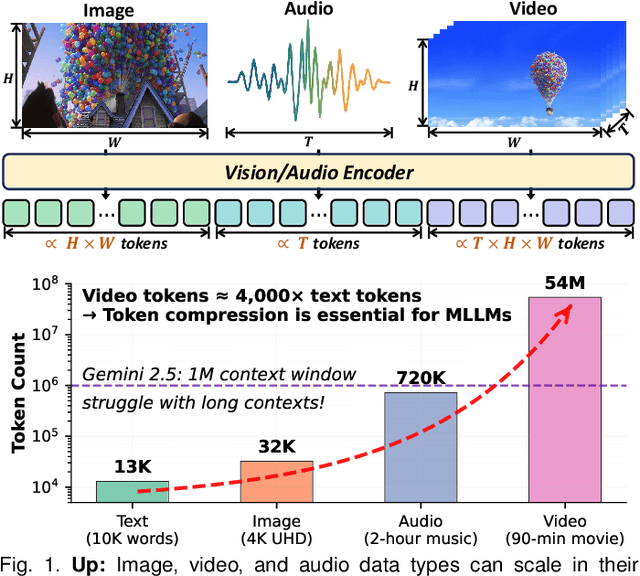
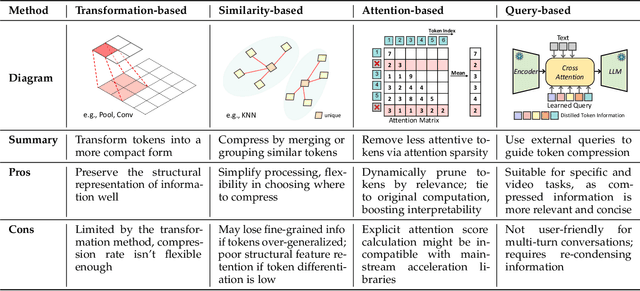
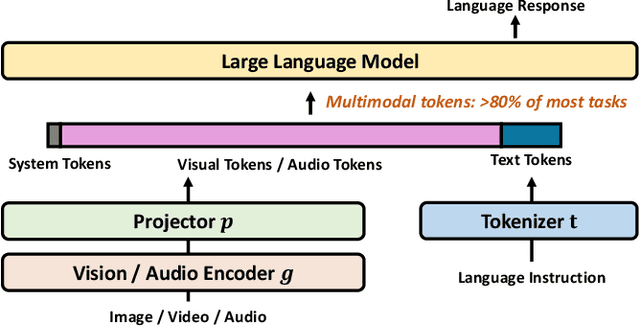
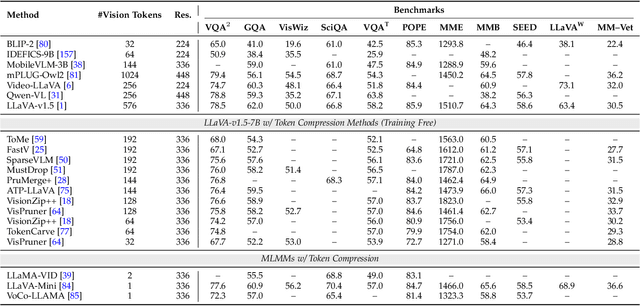
Abstract:Multimodal large language models (MLLMs) have made remarkable strides, largely driven by their ability to process increasingly long and complex contexts, such as high-resolution images, extended video sequences, and lengthy audio input. While this ability significantly enhances MLLM capabilities, it introduces substantial computational challenges, primarily due to the quadratic complexity of self-attention mechanisms with numerous input tokens. To mitigate these bottlenecks, token compression has emerged as an auspicious and critical approach, efficiently reducing the number of tokens during both training and inference. In this paper, we present the first systematic survey and synthesis of the burgeoning field of multimodal long context token compression. Recognizing that effective compression strategies are deeply tied to the unique characteristics and redundancies of each modality, we categorize existing approaches by their primary data focus, enabling researchers to quickly access and learn methods tailored to their specific area of interest: (1) image-centric compression, which addresses spatial redundancy in visual data; (2) video-centric compression, which tackles spatio-temporal redundancy in dynamic sequences; and (3) audio-centric compression, which handles temporal and spectral redundancy in acoustic signals. Beyond this modality-driven categorization, we further dissect methods based on their underlying mechanisms, including transformation-based, similarity-based, attention-based, and query-based approaches. By providing a comprehensive and structured overview, this survey aims to consolidate current progress, identify key challenges, and inspire future research directions in this rapidly evolving domain. We also maintain a public repository to continuously track and update the latest advances in this promising area.
DD-Ranking: Rethinking the Evaluation of Dataset Distillation
May 19, 2025



Abstract:In recent years, dataset distillation has provided a reliable solution for data compression, where models trained on the resulting smaller synthetic datasets achieve performance comparable to those trained on the original datasets. To further improve the performance of synthetic datasets, various training pipelines and optimization objectives have been proposed, greatly advancing the field of dataset distillation. Recent decoupled dataset distillation methods introduce soft labels and stronger data augmentation during the post-evaluation phase and scale dataset distillation up to larger datasets (e.g., ImageNet-1K). However, this raises a question: Is accuracy still a reliable metric to fairly evaluate dataset distillation methods? Our empirical findings suggest that the performance improvements of these methods often stem from additional techniques rather than the inherent quality of the images themselves, with even randomly sampled images achieving superior results. Such misaligned evaluation settings severely hinder the development of DD. Therefore, we propose DD-Ranking, a unified evaluation framework, along with new general evaluation metrics to uncover the true performance improvements achieved by different methods. By refocusing on the actual information enhancement of distilled datasets, DD-Ranking provides a more comprehensive and fair evaluation standard for future research advancements.
VGDFR: Diffusion-based Video Generation with Dynamic Latent Frame Rate
Apr 16, 2025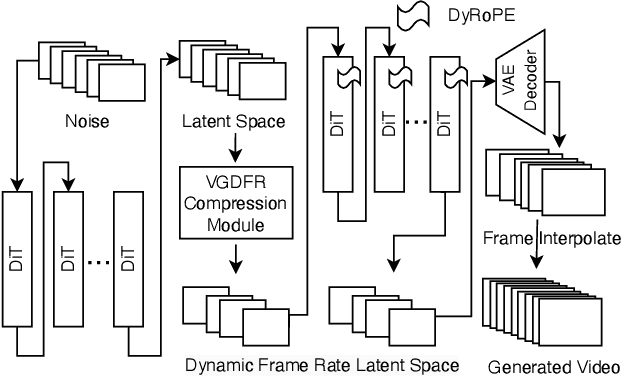
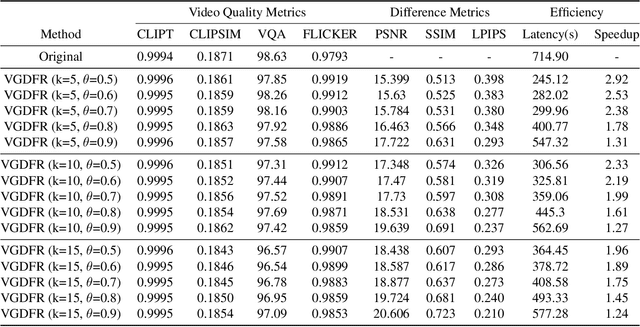

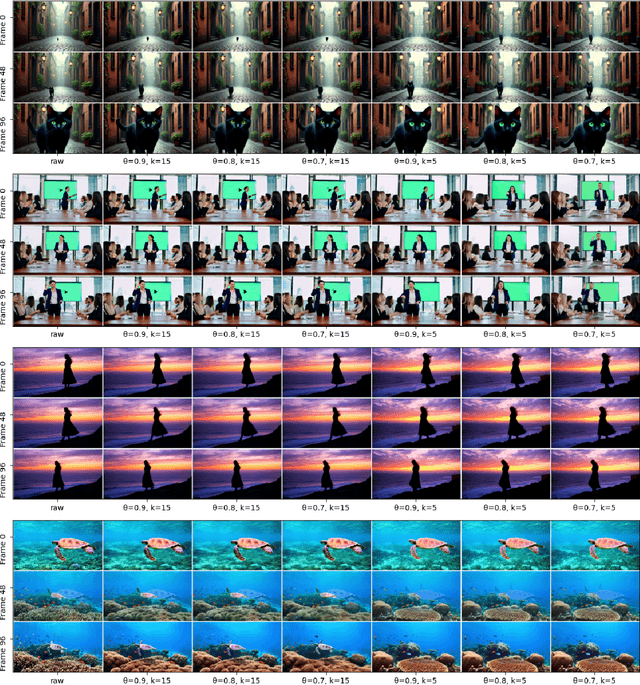
Abstract:Diffusion Transformer(DiT)-based generation models have achieved remarkable success in video generation. However, their inherent computational demands pose significant efficiency challenges. In this paper, we exploit the inherent temporal non-uniformity of real-world videos and observe that videos exhibit dynamic information density, with high-motion segments demanding greater detail preservation than static scenes. Inspired by this temporal non-uniformity, we propose VGDFR, a training-free approach for Diffusion-based Video Generation with Dynamic Latent Frame Rate. VGDFR adaptively adjusts the number of elements in latent space based on the motion frequency of the latent space content, using fewer tokens for low-frequency segments while preserving detail in high-frequency segments. Specifically, our key contributions are: (1) A dynamic frame rate scheduler for DiT video generation that adaptively assigns frame rates for video segments. (2) A novel latent-space frame merging method to align latent representations with their denoised counterparts before merging those redundant in low-resolution space. (3) A preference analysis of Rotary Positional Embeddings (RoPE) across DiT layers, informing a tailored RoPE strategy optimized for semantic and local information capture. Experiments show that VGDFR can achieve a speedup up to 3x for video generation with minimal quality degradation.
PTQ1.61: Push the Real Limit of Extremely Low-Bit Post-Training Quantization Methods for Large Language Models
Feb 18, 2025
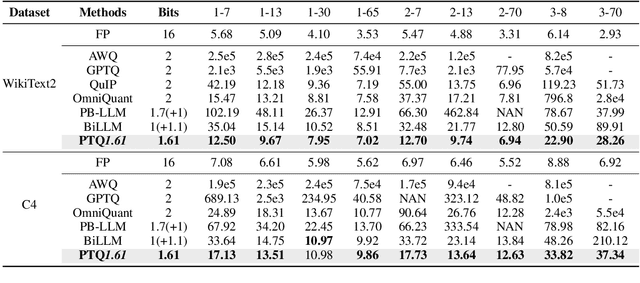
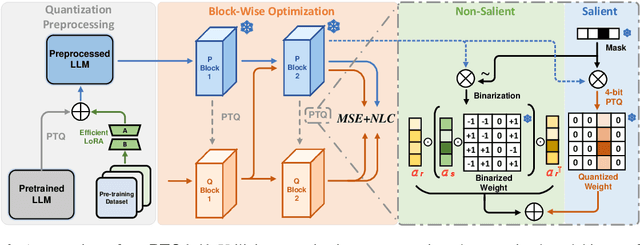
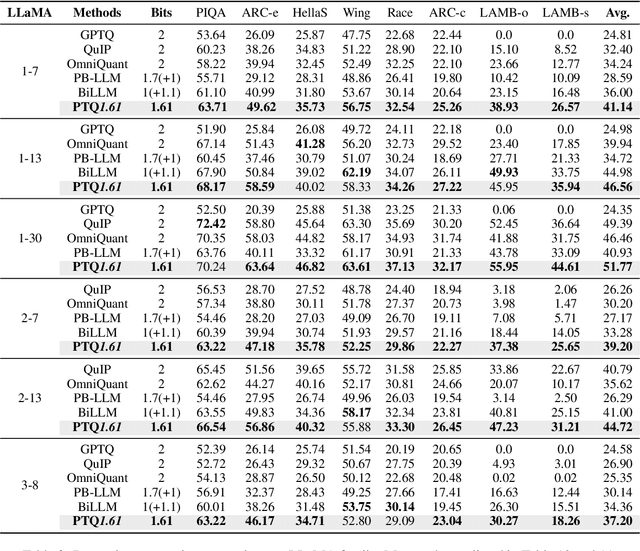
Abstract:Large Language Models (LLMs) suffer severe performance degradation when facing extremely low-bit (sub 2-bit) quantization. Several existing sub 2-bit post-training quantization (PTQ) methods utilize a mix-precision scheme by leveraging an unstructured fine-grained mask to explicitly distinguish salient weights, while which introduces an extra 1-bit or more per weight. To explore the real limit of PTQ, we propose an extremely low-bit PTQ method called PTQ1.61, which enables weight quantization to 1.61-bit for the first time. Specifically, we first introduce a one-dimensional structured mask with negligibly additional 0.0002-bit per weight based on input activations from the perspective of reducing the upper bound of quantization error to allocate corresponding salient weight channels to 4-bit. For non-salient channels binarization, an efficient block-wise scaling factors optimization framework is then presented to take implicit row-wise correlations and angular biases into account. Different from prior works that concentrate on adjusting quantization methodologies, we further propose a novel paradigm called quantization preprocessing, where we argue that transforming the weight distribution of the pretrained model before quantization can alleviate the difficulty in per-channel extremely low-bit PTQ. Extensive experiments indicate our PTQ1.61 achieves state-of-the-art performance in extremely low-bit quantization. Codes are available at https://github.com/zjq0455/PTQ1.61.
GSQ-Tuning: Group-Shared Exponents Integer in Fully Quantized Training for LLMs On-Device Fine-tuning
Feb 18, 2025Abstract:Large Language Models (LLMs) fine-tuning technologies have achieved remarkable results. However, traditional LLM fine-tuning approaches face significant challenges: they require large Floating Point (FP) computation, raising privacy concerns when handling sensitive data, and are impractical for resource-constrained edge devices. While Parameter-Efficient Fine-Tuning (PEFT) techniques reduce trainable parameters, their reliance on floating-point arithmetic creates fundamental incompatibilities with edge hardware. In this work, we introduce a novel framework for on-device LLM fine-tuning that eliminates the need for floating-point operations in both inference and training, named GSQ-Tuning. At its core is the Group-Shared Exponents Integer format, which efficiently represents model parameters in integer format using shared exponents among parameter groups. When combined with LoRA-like adapters, this enables fully integer-based fine-tuning that is both memory and compute efficient. We demonstrate that our approach achieves accuracy comparable to FP16-based fine-tuning while significantly reducing memory usage (50%). Moreover, compared to FP8, our method can reduce 5x power consumption and 11x chip area with same performance, making large-scale model adaptation feasible on edge devices.
 Add to Chrome
Add to Chrome Add to Firefox
Add to Firefox Add to Edge
Add to Edge